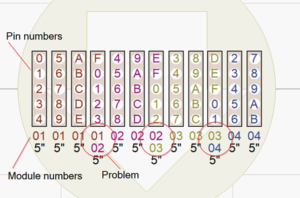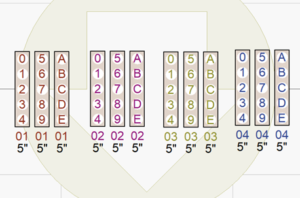Every display company has a different scheme for arranging its racks, but most companies arrange their racks in groups (“Clusters” in Finale 3D terminology) of some kind. Generally, companies do not want e-match wires extending between groups of racks, which imposes constraints on the firing system addresses.
Consider the example of a display company that uses Pyrodigital field modules with 16 pins, along with wooden racks with 5 tubes each, nailed together in clusters of three racks housing 15 tubes per cluster. The company attaches a single field module to each cluster.
For ease of setup, the company decides that it is willing to let one pin per module go unused, allowing the other 15 pins to match up with the 15 tubes in the rack assembly to which the module is attached. From an addressing perspective, this company needs to add the constraint that a module is restricted not to a single rack, but to a single rack cluster.
Table 1 – Sort order and constraints for eliminating wires between rack clusters
| Addresses sorted by | Position > Size > Angle |
| Modules constrained to same | Position, Size, Angle, Rack Cluster |
Addressing the show with these sort criteria and constraints will result in one module per rack cluster, and that module’s 16th pin will go unused to avoid wires running between the rack clusters. The two screenshots below show the effect of snapping the racks together into clusters before addressing. Both examples have the same sort criteria and constraints, from the table above. In the first example, the racks are addressed in one big group, and cannot subsequently be separated into clusters without wires running between the clusters. In the second example, the racks are arranged in clusters of three before assigning the addresses, and the Rack Cluster constraint ensures no wires run between the clusters.

Figure 1 – Impossible to split racks into clusters after addressing (photo: Finale 3D).

Figure 2 – Splitting the racks into clusters before addressing results in one module per cluster.
